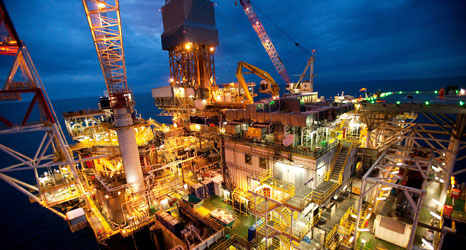
Beyond Shah Deniz: Azerbaijan’s Next-Generation Gas
Publication: Eurasia Daily Monitor Volume: 11 Issue: 18
By:

Azerbaijan is prepared to supply European Union countries with natural gas for decades to come and in growing volumes. The giant Shah Deniz field, where the producers’ consortium has just approved Phase Two of development (see EDM, January 14), is planned to start commercial production by 2018. Beyond Shah Deniz, however, Azerbaijan owns a number of medium-sized offshore gas and condensate fields, whose aggregate reserves can substantially boost the country’s export potential, once these fields come on stream.
According to Azerbaijan’s State Oil Company (SOCAR) president, Rovnag Abdullayev, Azerbaijan holds at least 2.5 trillion cubic meters of probable gas reserves, by current estimates; and its total gas export capacity should reach at least 40 billion cubic meters (bcm) per year, on top of internal requirements, by 2025 (Trend, News.Az, December 17, 28, 2013; January 13, 2014).
Slightly more than one half of those probable gas reserves are located at offshore fields other than Shah Deniz, being referenced as “next-generation gas.” Those medium-size fields, planned to come on stream commercially after Shah Deniz, are currently in various stages of appraisal or exploration. Given the chronic shortage of advanced drilling rigs in the Caspian Sea, however, these fields are unlikely to start commercial production earlier than 2020. The “next-generation gas” projects include (News.Az,January 13; Trend, December 18, 2013, January 23 and 28, 2014):
Shafag-Asiman: With estimated reserves of 500 billion cubic meters (bcm) of gas, these two fields are slated for development by BP and SOCAR, in a 50-50 joint venture. Based on an exploration and production contract signed in 2010 for a 30-year period, BP is the project operator during seismic surveying and exploration.
Absheron: This field’s development is a project of SOCAR, Total of France and Gaz de France Suez, holding 40 percent, 40 percent and 20 percent of the shares, respectively. It holds some 350 bcm of gas and 45 million tons of condensate.
Umid and Babek: The two fields contain approximately 600 bcm of gas and 40 million tons of condensate, as assessed after the drilling of the first exploration well. This is SOCAR’s project and the company is preparing to commission the second well.
Azeri-Chirag-Guneshli (ACG) Deep Layer: The clustered ACG fields account for the bulk of crude oil production in Azerbaijan. A reservoir of non-associated, natural gas, proven to contain some 300 bcm, is located below the oil deposits. Additional, promising offshore perimeters include Nakhchivan (under negotiation with RWE of Germany), Zafar-Mashal, Bulla Deniz and Karabakh, all in Azerbaijan’s sector of the Caspian Sea. Meanwhile, the associated gas captured during oil extraction is for the most part being re-injected into the oil reservoir to maintain pressure there. The non-associated, deep-layer natural gas, however, is planned for commercialization. The Azerbaijan International Operating Company (AIOC consortium) works the ACG fields based on the 1994 oil production-sharing agreement. At present, AIOC is comprised of project operator BP with 36 percent of the shares, SOCAR with 11.65 percent, as well as Chevron, Inpex, Statoil, Exxon, Turkish Petroleum, Itochu, and India’s ONGC with smaller stakes. Not all of the smaller shareholders will participate in the ACG deep-layer gas project. This is likely to be undertaken on the basis of a service contract with SOCAR, unlike the production-sharing agreement for the ACG oil project.
Shah Deniz: The field holds 1.2 trillion cubic meters of gas and 240 million tons of condensate. Phase One of production (ongoing since 2006) has yielded 9 bcm per year at full throttle until 2013, and will increase to 10.5 bcm annually from 2014 onward. Phase Two of production is planned to see the first gas flow in 2018 and to reach 16 bcm per year at full throttle after 2020. The high-value condensate production is planned to increase from 55,000 barrels per day (b.p.d.) during Phase One to 120,000 b.p.d. in Phase Two. The condensate is to be exported to international markets through the Baku-Tbilisi-Ceyhan oil pipeline.
The Shah Deniz production-sharing agreement (PSA) has just been prolonged to 2048. The consortium (reconfigured on December 17, 2013, with the final investment decision) presently comprises BP (project operator) with 28.8 percent of the shares; SOCAR (now elevated to commercial operator) 16.7 percent; Norway’s Statoil 15.5 percent; Total of France, Russian Lukoil and the National Iranian Oil Company at 10 percent each; and Turkish Petroleum with 9 percent.
According to BP’s CEO Bob Dudley, BP vice president Alasdair Cook overseeing this project, and BP’s Eurasia Exploration director Greg Riley, the Shah Deniz field is likely to contain additional reserves situated deeper than the proven gas layers. This could provide the basis for a Phase Three of the field’s development, referenced as Shah Deniz Deep, after Phase Two of production comes on stream. Within the PSA’s extended lifetime, the Shah partners will undertake further exploration in the PSA’s perimeter, including Shah Deniz Deep (Trend, December 17, 18, 2013; January 28, 2014).
Capitalizing on its untapped gas resources, and attracting Western companies into these joint projects, Azerbaijan is broadening its energy export portfolio from oil to natural gas. Baku is establishing physical interconnections with the European Union through dedicated gas pipelines. Azerbaijan itself is acquiring part-ownership in these pipeline projects, along the entire distance and value chain from Baku to the EU’s border. With this, Baku is laying the foundations for a strategic relationship with Europe, as a significant energy supplier for decades ahead.




